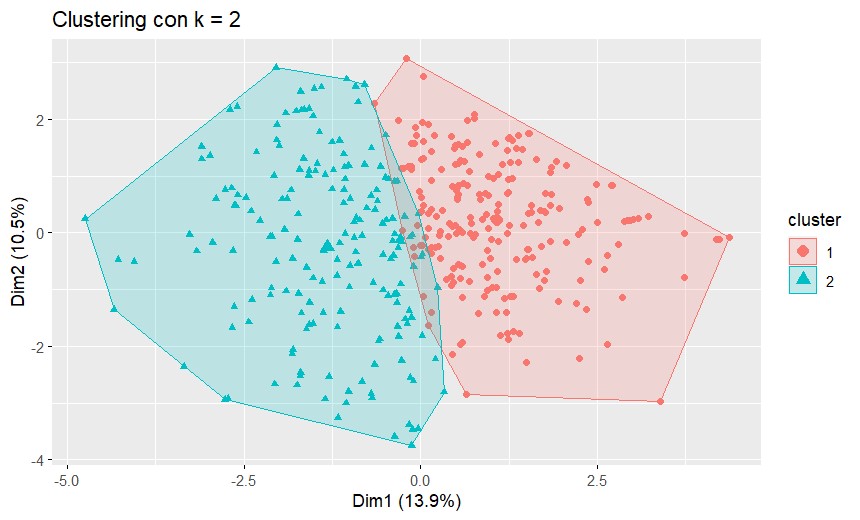Session Information
Session Type: Poster Session C
Session Time: 10:30AM-12:30PM
Background/Purpose: Systemic sclerosis is a systemic autoimmune disease with multiorgan involvement. Its pathophysiology is based on three pillars: vasculopathy, fibrosis, and autoimmunity. Despite advances in recent decades and a clear improvement in prognosis, there remains a subset of patients who develop early organ involvement. Therefore, patient stratification is essential to identify those most susceptible to organ involvement and to potentially anticipate its development. The objective of this study was to determine the existence of different groups in systemic sclerosis based on a clustering algorithm using clinical and serological variables.
Methods: An observational cross-sectional study was conducted with 402 patients diagnosed with systemic sclerosis, using data from the multicentric PRECISESADS study. Clinical (sex, age, interstitial lung disease, smoking…) and serological variables (autoantibody positivity) were collected from all patients.
Clustering algorithm following the k-means technique was applied to our participants, integrating age, ILD, smoking, sclerodactily, sex, PAH, calcinosis, arthritis, esophageal dismotility, Raynaud, telangiectasias, muscular weakness, GERD, digital ulcers and pitting scars. The optimal number of clusters was determined using the silhouette width method. Then, univariate analysis was performed to assess the differences between the clusters.
Results: Two groups were identified (Cluster 1 = 221 (54,97%) and Cluster 2 = 181 (46,03%)). The results of the univariate analysis are presented in Table 1. In the first cluster, we observed a slightly younger population (57.16 vs. 59.15 years), although this difference does not reach statistical significance (p = 0.12). Generally, patients in Cluster 2 exhibited a significantly higher prevalence of organ involvement, such as ILD (14.48% vs. 59.67%), PAH (9.05% vs. 30.94%), esophageal dysmotility (34.84% vs. 67.96%), and inflammatory joint involvement (20.81% vs. 39.78%).
Other systemic sclerosis characteristics were also more prevalent in Cluster 2, notably the presence of calcinosis (6.79% vs. 43.09%), digital ulcers (4.98% vs. 15.47%), and telangiectasias (39.82% vs. 83.43%).
We also conducted an analysis of the serological characteristics of the patients. Anti-centromere positivity was more frequent in Cluster 1 (43.44% vs. 29.28%), whereas anti-Scl70 positivity was more common in Cluster 2 (19.91% vs. 38.67%). The graphical distribution of the clusters is shown in Figure 1.
Comorbidities such as hypertension, dyslipidemia, smoking, and obesity did not show significant differences between both clusters.
Conclusion: These results suggest that identifying clusters may exhibit distinct clinical and serological profiles, suggesting the presence of heterogeneous subgroups within the systemic sclerosis population. This stratification could be pivotal in tailoring patient management and predicting disease progression. Further research is required to validate these findings and explore their clinical implications.
To cite this abstract in AMA style:
Dans Caballero S, López Medina C, Lopez-Pedrera C, Perez-Sanchez C, Escudero-Contreras A, Ortega-Castro R. Clustering Algorithm as an Exploratory Analysis of Different Clinical Phenotypes in Systemic Sclerosis. Data from the PRECISESADS Study [abstract]. Arthritis Rheumatol. 2024; 76 (suppl 9). https://acrabstracts.org/abstract/clustering-algorithm-as-an-exploratory-analysis-of-different-clinical-phenotypes-in-systemic-sclerosis-data-from-the-precisesads-study/. Accessed .« Back to ACR Convergence 2024
ACR Meeting Abstracts - https://acrabstracts.org/abstract/clustering-algorithm-as-an-exploratory-analysis-of-different-clinical-phenotypes-in-systemic-sclerosis-data-from-the-precisesads-study/


